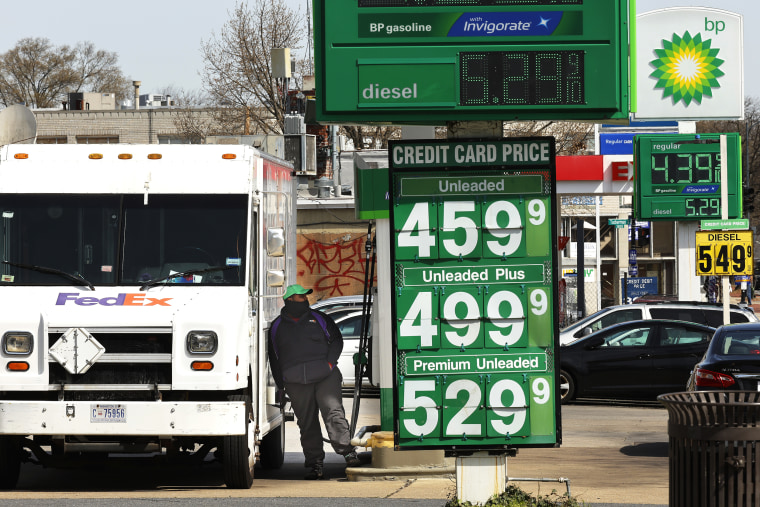Every time gas prices spike, the same questions get asked: Why are gas prices so high? Who’s to blame? What will bring them down?
These aren’t terrible questions, and they’re logical in a country where the majority of people are car owners. But the fact that we keep having these questions, decade after decade, suggests they’re also insufficient. They narrow the focus to weak, short-term fixes with which elected officials, eager to avoid blame for the proverbial pain at the pump, rush in. The president taps reserves. Governors suspend gas taxes. Never mind that these stopgap measures don’t do much to tide consumers over until prices subside. Indeed, on Tuesday, President Joe Biden announced plans to increase the production and sale of ethanol-blended gasoline; this comes just a few weeks after he announced plans to release millions of barrels of oil from the Strategic Petroleum Reserve.
Why does gas price volatility have the power to cause so much pain? The answer, of course, is parked in America’s driveways.
A better question may be: Why does gas price volatility have the power to cause so much pain? The answer, of course, is parked in America’s driveways.
AAA calculated last year that gas accounted for just 16 percent of the annual cost of owning a compact SUV and driving it 15,000 miles (the yearly average). Last month, the national average price of a gallon reached $4.34. We’re already down from that peak, but if it were sustained for a year, gas would reach just 25 percent — 1 of every 4 dollars — of the cost borne by the same vehicle owner.
What this tells us is when it comes to costs, gas isn’t the crux of the problem — cars are. What gas price spikes do is pierce the fantasy that our transportation system, overly dependent on cars, is sustainable.
This fantasy persists because so many household vehicle costs are hidden. (That’s not to mention externalized costs.) Gas station signs are highly visible, but the many costs of car ownership and operation are broken up across our budgets, often on autopay: financing, depreciation, insurance, repairs, maintenance, taxes, fees, fines, parking, tolls. Gas prices go up and down, sometimes violently, in front of our eyes, but these other, easier-to-ignore costs just keep rising.
The average price of a new car hit a new high last year at $47,000. Automakers’ aggressive marketing of more expensive, larger vehicles — which require high, long-term debt, stretch budgets to their limit and tend to consume more fuel — make gas price spikes much more painful than they need to be for middle-class people. Because periods of lower gas prices seem to contribute to amnesia about their volatility, light trucks, vans and SUVs now outsell cars by 3 to 1. It’s these buyers especially who put pressure on politicians, who respond by feeding the belief that lowering gas prices is the ultimate answer.
What’s key is that while a small proportion of household spending on vehicles goes to the government to help fund roads, most goes to the giant corporations that sell cars, make car loans and provide car insurance. As a result, our transportation system is an inequality generator, sucking up dollars from lower- and middle-income families, small businesses and local communities and spraying them at not just big oil but also big banks, big insurance and big auto.
And while high gas prices inevitably hurt lower-income workers the most, the costs of car ownership crush the poor no matter the price of gas. An unlikely source, an Applebee’s executive, highlighted recently how many people must work more hours to pay for the car they need to get to work. He was rightly vilified, but he wasn’t wrong about this: Our dependence on cars can trap people in bad jobs, while corporations large enough to weather gas spikes benefit in ways we don’t imagine.
Many proponents of keeping gas flowing point to the plight of the working families, but too many offer the wrong solutions, including predictable calls for more domestic drilling. But all evidence — social, economic, environmental — demonstrates we need to reduce our dependence on gasoline, and now. Electric cars may help, but waiting for the car to solve the problems of the car has led us to this point: the precipice of catastrophe.
We’ve been waiting for electric vehicles to save us any minute now for decades. They account today for less than 1 percent of vehicles on our roads. Perpetuating the belief that cheap gas or electric cars will solve our transportation problems doesn’t just focus too narrowly on automotive solutions — it has slowed progress on non-automotive ones. Critics of transit who complain it can take decades for investments in public transit to be realized claim that nimble private companies can bring a better future more quickly. They have been proven wrong.
So what to do? It must be made safer and easier for people to be able to drive less and be more mobile through smarter planning, low-cost pedestrian and cycling infrastructure and vastly improved and expanded transit. And if owners realize they may be spending more on their vehicles than they imagined and can spend less to get what they need, they can help make the next gas price spike a less painful one.
